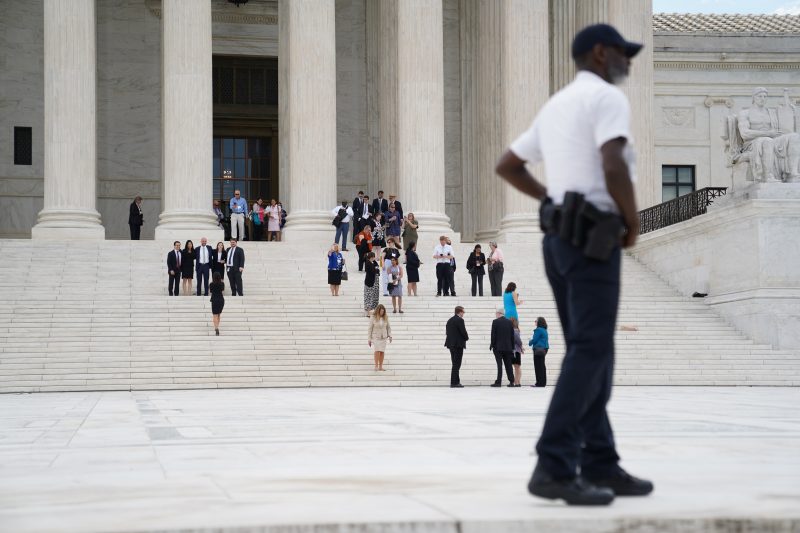The Supreme Court on Tuesday reversed the conviction of a man who made extensive online threats to a stranger, saying free speech protections require prosecutors to prove the stalker was aware of the threatening nature of his communications.
In a 7-2 ruling with Justice Elena Kagan writing for the majority, the court emphasized that true threats of violence are not protected by the First Amendment. But to guard against a chilling effect on non-threatening speech, the majority said, states must prove that a criminal defendant has acted recklessly, meaning that he “disregarded a substantial risk that his communications would be viewed as threatening violence.”
Justice Sonia Sotomayor, joined in part by Justice Neil M. Gorsuch, agreed with the outcome but expressed concern about the risk of cracking down on speech that is unintentionally threatening. She worried that the ruling could lead, for instance, to a high school student going to prison for sending another student violent music lyrics.
Justices Clarence Thomas and Amy Coney Barrett dissented from the majority, with Barrett writing that the standard set by the court on Thursday gives “preferential treatment” to a broad range of threatening speech and makes it more difficult for law enforcement to address actual threats.
“A delusional speaker may lack awareness of the threatening nature of her speech; a devious speaker may strategically disclaim such awareness; and a lucky speaker may leave behind no evidence of mental state for the government to use against her,” Barrett wrote. “The Court’s decision thus sweeps much further than it lets on.”
The case concerned a Colorado law used to convict Billy Raymond Counterman of stalking and causing “emotional distress” to Coles Whalen, a singer-songwriter he had never met. Counterman, who had previously been convicted of making threats to others, served four years in prison in the Whalen case.
The court’s interest involved the question of when statements, especially those made online, can be considered “true threats” not protected by the First Amendment.
Counterman contended that the state must show that the speaker intends the messages to be threatening. Colorado, backed by the Justice Department and a majority of states, says it should be enough that a “reasonable” recipient feel that physical harm could be imminent, on the basis of the context of the circumstances.
The case returns to the lower courts, where prosecutors could decide to retry the matter under the new standards set by the Supreme Court’s decision.
Supreme Court 2023 decisions
End of carousel
Whalen testified at Counterman’s trial, and told The Washington Post in an interview, that she was terrified by Counterman’s relentless pursuit. She said she never knew whether her stalker would be in the crowd at her performances. The worry affected her mental health, caused her to cancel concerts and hampered her career and even caused her for a time to give up performing, she said.
For years, when she blocked Counterman from her Facebook page, which she used to publicize her appearances and her work, he formed new profiles and continued sending the messages.
Whalen eventually sought help from a lawyer, who researched Counterman’s background and told her of his previous convictions. “I was already scared, but then I was terrified,” Whalen said in the interview. “I thought, ‘Why did I wait so long?’”
Among the messages presented at Counterman’s trial:
“I’m currently unsupervised. I know, it freaks me out too, but the possibilities are endless.”
“F— off permanently.”
“You’re not being good for human relations. Die. Don’t need you.”
The Supreme Court last confronted the true-threats question in 2015, when justices reversed the conviction of a Pennsylvania man who had made violent and graphic statements against co-workers and his estranged wife. Anthony Elonis said his postings were therapeutic rants. The court found that federal law required more evidence about Elonis’s intent but left the First Amendment question unsettled, opening the door for this lawsuit.
In Counterman’s case, the justices were revisiting the limits of free speech. The majority cited the court’s past rulings in explaining why it shares Counterman’s concerns about deterring or silencing protected types of speech and expression.
“Our decisions have often insisted on protecting even some historically unprotected speech through the adoption of a subjective mental-state element,” Kagan wrote. “We follow the same path today, holding that the State must prove in true-threats cases that the defendant had some understanding of his statements’ threatening character.”
In addition, the majority held that to lose constitutional protections for what they say, speakers must “recklessly” disregard the threatening nature of their speech. That means, Kagan wrote, that the speaker knows that others could consider the statements as threatening violence and makes them anyway.
Sotomayor said she was concerned about overzealous prosecution and for that reason would set a higher bar than recklessness for proving that certain speech is a “true threat.”
“True threats encompass a narrow band of intentional threats,” she wrote. “Especially in a climate of intense polarization, it is dangerous to allow criminal prosecutions for heated words based solely on an amorphous recklessness standard.”
Sotomayor noted that different corners of the internet have “considerably different norms around appropriate speech” and that online posts may lack the usual context clues, such as tone and expression.
A jury’s determination about “when angry hyperbole crosses the line will depend on amorphous norms around language, which will vary greatly from one discursive community to another,” Sotomayor wrote. “Unfortunately yet predictably, racial and cultural stereotypes can also influence whether speech is perceived as dangerous.”
In dissent, Barrett rejected the recklessness standard set by the majority as “not grounded in law.” She listed some potential negative consequences of the court’s ruling, including scenarios in which a person threatens to bomb an airport or to shoot up a courthouse.
“The speaker might well end up barred from the location in question — for good reason,” wrote Barrett, joined by Thomas. “Yet after today, such orders cannot be obtained without proof — not necessarily easy to secure — that the person who issued the threat anticipated that it would elicit fear.”
Kagan acknowledged the competing interests in protecting speech and prosecuting true threats. The court’s approach, she wrote, finds a middle ground by offering “‘enough “breathing space” for protected speech,’ without sacrificing too many of the benefits of enforcing laws against true threats.”
The case is Counterman v. Colorado.



























